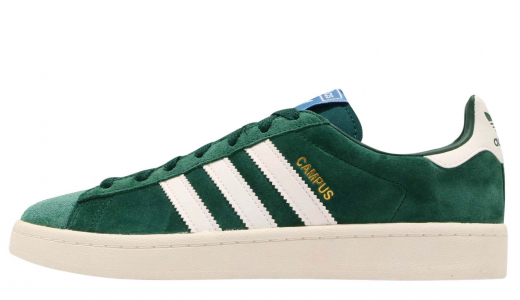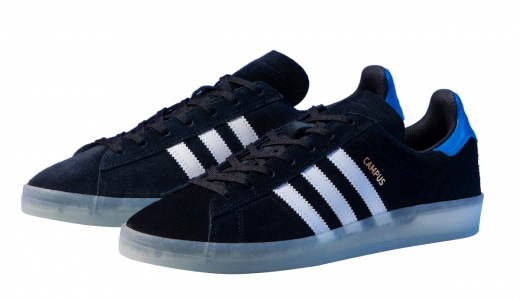Adidas Campus
The adidas Campus is a legendary silhouette in the world of sneakers, a quintessential example of timeless design fused with street-style charisma. Originally launched in the early 1980s, the Campus quickly became a staple within hip-hop culture and on college campuses alike. Its minimalistic design features a smooth suede upper, reinforced with the brand's iconic three stripes and subtle branding. The silhouette's clean lines, low-top built, and cushioned sole make it exceptionally versatile, suitable for casual outings and athletic activities. Over the years, adidas has reimagined the Campus in various colorways and materials, yet the essence of its sleek, understated elegance remains untouched.
The versatility of the adidas Campus extends beyond its design, making it a canvas for creativity and self-expression among sneaker enthusiasts. Celebrities, fashion icons, and streetwear aficionados have all embraced the Campus, each adding their own spin and contributing to its rich cultural tapestry. This sneaker has witnessed generations of evolution, from the hip-hop scenes of the '80s to modern-day fashion runways, solidifying its place in the annals of sneaker history. Its enduring appeal stems from its ability to seamlessly blend with different styles while maintaining a classic, enduring look. Whether paired with jeans, joggers, or even skirts, the adidas Campus continues to defy trends, embodying a legacy of comfort and effortless cool.
History of Adidas Campus
The History of the Adidas Campus
The Adidas Campus is a classic sneaker that has evolved from a niche basketball shoe in the late 1970s to an iconic piece of athletic and streetwear fashion. This journey is replete with innovations, cultural shifts, and strategic branding moves that have cemented its status as a timeless classic in the world of footwear. This comprehensive history will traverse multiple decades, geographic borders, and cultural phenomena to elucidate the evolution of the Adidas Campus.
Origins and Early Days
The Birth of Adidas
To understand the story of the Adidas Campus, one must first appreciate the history of its parent company, Adidas. Founded by Adolf "Adi" Dassler in 1949 in Herzogenaurach, Germany, Adidas quickly grew to become a titan in the sportswear industry. Initially focusing on athletic shoes, the brand's reputation was buoyed by its innovative designs and quality.
The Initial Concept
By the late 1970s, Adidas was not only a household name in sports communities but also an influential player in lifestyle fashion. The Adidas Campus first arrived in 1978, originally branded as the “Tournament.” It was launched as a low-top basketball shoe featuring a durable suede upper, rubber outsole, and the signature Adidas three stripes. The shoe catered specifically to basketball enthusiasts but was designed with enough versatility to appeal to a broader audience.
The 1980s: The Rise of a Classic
Basketball and Beyond
The 1980s saw the Adidas Campus transition from the court to the streets. Basketball players appreciated the shoe for its comfort and durability, but it was its street-ready look that started gaining traction among non-athletes. The design featuring suede material and a minimalistic aesthetic resonated with urban youth culture, starting a trend that Adidas wisely capitalized on.
Hip-Hop Culture
One of the turning points for the Adidas Campus came when it was adopted by the burgeoning hip-hop culture in New York City. Groups like Run-D.M.C., who famously donned Adidas Superstars, also popularized the Campus style. The sneaker's simple yet appealing design made it a favorite among breakdancers, graffiti artists, and rappers. As hip-hop culture gained mainstream popularity, so did the Adidas Campus, forever linking the brand to this vibrant subculture.
The 1990s: Expansion and Reinvention
Skateboarding Scene
The 1990s marked another pivotal moment for the Campus sneaker as it found a new fanbase within the skateboarding community. Skateboarders loved the shoe's robust construction, which could withstand the rigors of skateboarding. Adidas capitalized on this trend, subtly modifying the shoe to meet the specific needs of skaters, such as adding extra padding and improving the grip.
Fashion Statements
By this time, the Campus had transitioned from a specialized athletic shoe to a staple in casual wear. Designers and fashion influencers started incorporating the Campus sneaker into their collections, bringing it to high fashion runways and magazines. Its minimalist design and versatile color options made it an easy fit for various styles, from street casual to chic and sophisticated looks.
The 2000s: Global Presence and Collaborations
Global Market Penetration
In the 2000s, Adidas continued to build on its global brand and ensure that the Campus sneaker remained relevant in an increasingly competitive market. The shoe was exported to various countries where it was adopted into local styles and cultures. It became particularly popular in Japan and other Asian markets, thanks to the region's growing fascination with Western streetwear.
Collaborations
One of the strategies Adidas employed to keep the Campus fresh and exciting was through collaborations with designers, celebrities, and other brands. Limited edition Campus sneakers created in partnership with designers like Mark Gonzales, a legendary skateboarder, and brands like Bape (A Bathing Ape) added an element of exclusivity and desirability. These collaborations not only reinvigorated the brand but also expanded its appeal to collectors and fashion aficionados.
The 2010s: Nostalgia and Retro Revival
The Vintage Appeal
As the fashion world began to indulge in nostalgia, the revival of vintage styles became a significant trend in the 2010s. The Adidas Campus, with its rich history and iconic design, was perfectly positioned to benefit from this movement. Adidas launched several retro releases, reviving original colorways and materials that evoked the original 1978 silhouette. These releases were met with enthusiasm from both older fans and a new generation discovering the Campus for the first time.
Digital Age and Social Media
The rise of social media also played a crucial role in the Campus's enduring popularity. Platforms like Instagram, Twitter, and Facebook became spaces where influencers and ordinary people showcased their latest sneaker purchases and outfits. The Adidas Campus frequently appeared in social media feeds, further entrenching its status as a must-have item.
The Present: Sustainability and Future Directions
Sustainability Efforts
As we moved into the 2020s, sustainability became a critical focus for Adidas. The Campus sneaker line started incorporating eco-friendly materials and production processes. Adidas introduced versions of the Campus made with recycled materials, organic cotton, and sustainable suede, aligning the classic sneaker with modern environmental concerns. This commitment to sustainability broadened its appeal to eco-conscious consumers.
Modern Collaborations
In keeping with its tradition, Adidas continues to look for new collaborations to maintain the Campus's relevance. Recent partnerships involve contemporary artists, musicians, and fashion labels, ensuring that each new release feels fresh yet remains true to the brand's legacy. Collaborations with well-known figures like Pharrell Williams and Jonah Hill have added modern twists to the classic design, engaging both older fans and new consumers.
The Role in Modern Fashion
The Adidas Campus remains a versatile piece in the modern fashion landscape. Its design has proven to be timeless, easily adaptable to various styles, from athleisure to high fashion. The shoe's enduring appeal lies in its ability to be both a statement piece and a reliable, everyday sneaker. It has been featured in numerous fashion editorials and has graced the feet of celebrities, athletes, and ordinary people alike.
Global Influence
Today, the Adidas Campus enjoys global recognition and is an essential part of the brand's portfolio. Its influence extends beyond the confines of sports and fashion, touching upon music, art, and pop culture. The shoe symbolizes a blend of performance and style, making it a perennial favorite across different demographics and regions.
Conclusion
The history of the Adidas Campus is a testament to the power of timeless design, cultural relevance, and strategic innovation. From its inception as a niche basketball shoe to its current status as a global fashion icon, the Campus has navigated decades of changing trends and market dynamics. Its journey mirrors broader cultural shifts, reflecting the evolution of sports, music, and fashion over the years.
Whether it’s the tales from the basketball courts of the 1970s, the hip-hop streets of the 1980s, the skate parks of the 1990s, or the fashion capitals of today, the Adidas Campus has been a constant, adaptable presence. It serves as a bridge between generations, offering a piece of history that continues to be written with every new iteration and collaboration.
As we look to the future, the Adidas Campus is poised to stay relevant, driven by its unique blend of heritage, innovation, and adaptability. In a world where fashion and culture are in constant flux, the Adidas Campus stands as a reassuring symbol of enduring style and substance.























